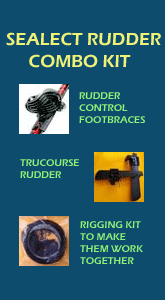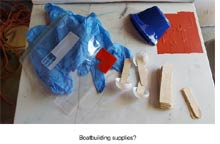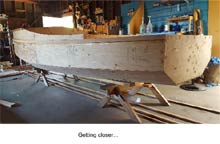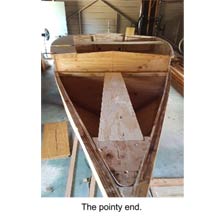
 Custom Search
|
| boat plans |
| canoe/kayak |
| electrical |
| epoxy/supplies |
| fasteners |
| gear |
| gift certificates |
| hardware |
| hatches/deckplates |
| media |
| paint/varnish |
| rope/line |
| rowing/sculling |
| sailmaking |
| sails |
| tools |
| join |
| home |
| indexes |
| classifieds |
| calendar |
| archives |
| about |
| links |
| Join Duckworks Get free newsletter CLICK HERE |
|
|
| Building a Frolic2 - Part Two |
by Robert Jacobs - Fresno, California - USA |
Part One - Part TwoI certainly never intended to write a blow by blow account of this boat build, but then I never intended to write ANYTHING about this boat build. For that matter, I never really even intended to build this boat at all, and was gearing up to build another I had just bought plans for (still have 'em), so there you go. Life is strange like that. It really would be unfair, though, in chronicling this boat, to skip over some of the pangs of growth, to gloss over the very real labors involved in her creation. To leave the impression that this boat flies together instantly, that it all comes together like so much Bippity Boppity Boo, would be unfair. This is a lot of work, y'all, especially if you ain't in great shape, and ain't done it a whole bunch before. Luckily, I am, and I have... Instead of a how-to, then, the dry old step-by-step, why not answer the hard question? Why? Why-to build this boat? Indeed. The simple answer is, there is no simple answer. I was fired up to build a different boat, and then, fairly suddenly, I decided to build this one. It sure does meet the requirements of being a different boat, eh? That's not what I meant by different, and you know it. So do I, but sometimes I just can't help myself. Now, this boat is simple and quick to build, as these things go, but this is still a 20-foot sailboat with a cuddy cabin and decking. There is a lot happening, here, folks. None of the individual steps are beyond the mechanical aptitude of the average handyman, or high school shop class graduate, or, shoot, anyone who took a night school course to learn some woodworking skills. That said, there are a bunch of fiddly bits, even in a simple boat like this, and a fair amount of fitting and screwing (or nailing, or even stapling/bradding) and gluing. Did I mention all the mixing and whupping of gloops and schmootzes? There is very little here, yet there is so much. Crazy. This austere functionality is an aesthetic value I appreciate, because I am a very ascetic guy myself, in almost all aspects of my life. Not just in my everyday, personal life, but also in my own design work (I do not design boats) and in my art. I've been a fan of this school of thought as it relates to boats since I discovered the late, great Phil in the library at college, while I was ditching class to get an education. This boat seems to suit me, my own style, my personal design aesthetic and ethos. I appreciate the austerity and efficiency, even down to the recycling of a design motif, because why broke it if it ain't fixed, right? Wait... A moment of true disclosure. We once came very close to building a Birdwatcher variant, but youthful indigence and foolishness on our end soured the whole deal, and it ended with well deserved (though innocuous and humorous) harangues and admonishments from Ms. A, and deep pangs of regret. Perhaps I consider this Frolic some type of slot-top atonement to one of my departed heroes (is this writing, then, a paean to Vonnegut?)?
The more I touch this boat, form it in the real world, the more I come to appreciate and admire it. The more I come to cherish it, not because I made it with my own hands, because that would hardly qualify an item as unique in my world, but because as it comes alive in three dimensions, I am fully realizing the beauty of this boat. Really, all those lovely pictures of Oaracle on the web pale in comparison to this half-baked pie in my garop (that's the garage/shop, for y'all what's been wondering). In the flesh, she really is a lovely boat, even unpainted, with unfinished outer seams. Which reminds me about the construction method. There may not be a quicker way to build a boat this size. There are more than a few fiddly, little bits, to be sure, and several enormous, initially floppy ones, but the parts are essentially the whole, with little extraneous material used in construction. The boat jigs and forms itself over permanent, pre-made bulkheads and a few temporary molds, and what begins as a seemingly rickety structure becomes very rigid once screwed and wired together. After it's together and straight and true, it gets glued, then glassed, then sanded and sanded and sanded and sanded and sanded and sanded, then painted, and sanded and sanded and sanded, and it's a boat. I've done a few boats like this, and it always amazes me, both how rigid they become, and how quickly it all flies together.
This savings in time was an enormous factor in deciding to build this boat. If this were a more conventional build, like the other boat I was contemplating, I would be setting these molds up on a horse right now, instead of gluing together my boat already. Several months of sailing time are worth, what? Better yet, what's it worth to begin building and sailing a boat this size in the same season? Totally possible, looking more probable, and somewhat a factor, I should say. Does the construction method dictate the shape of the boat, though? That is, are we conceding quality for ease of construction in a boat such as this? I'm not sure, but a sistership has done quite well in several of the Everglades Challenges, including some with fairly severe weather, so I'm sure the vessel is theoretically capable of any sailing I might demand of it. I also notice she has a shape not unlike that of the modern mono hull sleds, and is reported to be a good downwind sailer, especially in light air, and also capable of surfing in heavier going. On top of that, she is reported to get to windward just fine, thank you. Perhaps, if the design is constrained in any way by build methodology, we can say he used the constraints to best advantage. So far, I have all the inside seams done, an epoxy fillet followed by a layer of fiberglass tape set in neat resin, and after they cure a few days, this bad boy is gonna have to flip over and get glassed on the outside. The plans call for glass on the bottom panel and taped seams, but in light of how doug fir checks, and how adventurous I get in my boats, I thought it best to sheathe the entire hull, below the gunwales, with another layer over the bottom and just up and over the chines, in place of the tapes. I think it will make a much smoother, stronger hull, and still allow two layers of cloth at each joint. I'm honestly still undecided about how to finish the decks and cabin top. The fir will check if left uncovered, so I thought to put some light weight glass over all those surfaces. The other alternative is to glue muslin or light canvas down and paint over that, like an old timey boat. It works very well, thank you, and it looks sort of traditional, especially if the weave of the cloth shows through the paint just a bit. That's the real trick to building your own boat, though, making those 1,001 little choices or decisions that pop up during the effort. Of course, the plan of any designer should be followed closely as regards shape, material spec, rig, etc, because these are the vital things that make a boat what it is. It is the innumerable little decisions, though, the finish, that makes a boat yours. There are as many ways to build and outfit boats as there are boats, and these are the areas where experience pays. Some details aren't included in the plan, and are often the place where first time boat builders stumble, I know I did. I still do. Upon examination, for example, and based on my experience and accumulated knowledge, I intend to add a small breasthook tied into a sort of kingplank which is in turn tied into the fore deck beam. I got big kids and a big dog, and I want the mooring cleat to be tied into something fairly hefty, too. It is a little extra weight, and it is rather high up, but I intend to do some adventuring in this boat with no engine, so I imagine being very dependent on that mooring cleat one day, and I'd feel better knowing it is well tied into everything. Added weight is a serious issue, though, and a very common mistake people make when building things, especially boats. There is always a trade-off for weight added. Perhaps the performance will be reduced, or, at least, altered, perhaps enough to render the craft unusable, even dangerous. There is rarely any measurable improvement in strength. The temptation is there to beef up this and strengthen that, which, for the most part is an affront to the designer. I say for the most part, because sometimes substitutions in materials must needs be made, or sometimes experience prevails. I've had a thin ply deck crack right around the edges of a highly loaded backing block before, so I want to make sure the anchor cleat on my adventure boat is plenty strong, even at the sacrifice of a pound or so of extra weight.
That's all for the future, though. There's a lot more schmootzing to do before any of that happens. And a ton of sanding and fairing left to do on the outside. To say nothing of the foils, because they will be foiled, the sticks for the sails (remember, I don't follow my own advice, and I'm changing the plan, adding a mizzen), the sticks for rowing and sculling (I'm thinking a yuloh style oar might could come in very handy, as could a quant, or push pole), and then all the painting and sanding and painting and sanding and painting and sanding and painting and sanding. Baby steps. |
To comment on Duckworks articles, please visit one of the following:
|
 |






